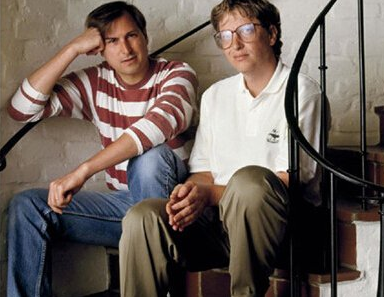When the Macintosh was first being developed, Jobs went up to visit Gates at his office near Seattle.
當(dāng)蘋果開始著手研發(fā)麥金塔電腦時(shí),喬布斯前去拜訪蓋茨。
Microsoft had written some applications for the Apple II, including a spreadsheet program called Multiplan,
微軟曾為蘋果的Apple II電腦編寫過一些應(yīng)用程序,其中包括名為“Multiplan”的電子表格程序。
and Jobs wanted to excite Gates and Co. about doing even more for the forthcoming Macintosh.
這一次,喬布斯想鼓動(dòng)蓋茨和微軟為其即將推出的麥金塔電腦編寫更多程序。
Sitting in Gates's conference room, Jobs spun an enticing vision of a computer for the masses,
坐在蓋茨位于西雅圖華盛頓湖邊的會(huì)議室中,喬布斯勾畫出一幅誘人的圖景,
with a friendly interface, which would be churned out by the millions in an automated California factory.
加利福尼亞的某家自動(dòng)化工廠將會(huì)大批量生產(chǎn)界面友好的大眾電腦。
His description of the dream factory sucking in the California silicon components
在他的描述中,硅元件被送進(jìn)工廠,完整的麥金塔電腦魚貫而出。
and turning out finished Macintoshes caused the Microsoft team to code-name the project "Sand."
微軟團(tuán)隊(duì)因此給該項(xiàng)目取了個(gè)代號(hào),叫“沙”。
They even reverse-engineered it into an acronym, for "Steve's amazing new device."
他們甚至又把它演繹成了一句話的縮略詞:史蒂夫的神奇新機(jī)器

Gates had launched Microsoft by writing a version of BASIC, a programming language, for the Altair.
蓋茨創(chuàng)立微軟,是源于為阿爾泰計(jì)算機(jī)編寫B(tài)ASIC語言版本。
Jobs wanted Microsoft to write a version of BASIC for the Macintosh,
喬布斯希望微軟為麥金塔電腦編寫B(tài)ASIC程序
because Wozniak--despite much prodding by Jobs--had never enhanced his version of the Apple II's BASIC to handle floating-point numbers.
因?yàn)楸M管喬布斯多次敦促,沃茲尼亞克從未改進(jìn)Apple II的BASIC語言版本以提髙處理浮點(diǎn)數(shù)的能力。
In addition, Jobs wanted Microsoft to write application software--such as word processing and spreadsheet programs--for the Macintosh.
此外,喬布斯還希望微軟能為麥金塔電腦編寫一些應(yīng)用軟件,如文字處理軟件、圖表和電子表格程序。
At the time, Jobs was a king and Gates still a courtier:
當(dāng)時(shí),喬布斯已功成名就,蓋茨還只是個(gè)跟班:
In 1982 Apple's annual sales were $1 billion, while Microsoft's were a mere $32 million.
1982年,蘋果公司的年銷售額達(dá)10億美元,而微軟只有3200萬美元。
Gates signed on to do graphical versions of a new spreadsheet called Excel, a word-processing program called Word, and BASIC.
蓋茨簽下了合同,除BASIC程序外,還為蘋果公司開發(fā)圖形界面版本的軟件--文字處理程序Word和全新的電子表格軟件Excel。
Gates frequently went to Cupertino for demonstrations of the Macintosh operating system, and he was not very impressed.
蓋茨經(jīng)常去庫比蒂諾觀看麥金塔操作系統(tǒng)的演示,但是并沒有多大觸動(dòng)。
"I remember the first time we went down, Steve had this app where it was just things bouncing around on the screen," he said.
“我記得第一次去的時(shí)候,史蒂夫運(yùn)行了一個(gè)應(yīng)用程序,不過就是一些東西在屏幕上跳來跳去,”他回憶說,
"That was the only app that ran."
“這是唯一能夠在他們機(jī)器上運(yùn)行的應(yīng)用程序。”
Gates was also put off by Jobs's attitude.
此外,喬布斯的態(tài)度也令蓋茨反感。
"It was kind of a weird seduction visit, where Steve was saying,
“我們此行有點(diǎn)兒被誘騸的詭異感覺。史蒂夫說,
'We don't really need you and we're doing this great thing, and it's under the cover.'
我們也不是真的需要你們,我們正在做的這個(gè)東西很偉大,它還處于保密之中。
He's in his Steve Jobs sales mode, but kind of the sales mode that also says, 'I don't need you, but I might let you be involved.'"
這是他自己慣用的銷售方式,潛臺(tái)詞是'我不需要你,但可能會(huì)讓你參與進(jìn)來。'”
The Macintosh pirates found Gates hard to take.
麥金塔團(tuán)隊(duì)的“海盜們”也覺得蓋茨令人難以忍受。
"You could tell that Bill Gates was not a very good listener.
“你會(huì)發(fā)現(xiàn),比爾·蓋茨不是個(gè)很好的聽眾
He couldn't bear to have anyone explain how something worked to him
他不接受任何人向自己解釋某個(gè)東西如何運(yùn)作,
he had to leap ahead instead and guess about how he thought it would work," Hertzfeld recalled.
他要搶在別人前面提出他對這個(gè)東西如何運(yùn)轉(zhuǎn)的推斷,猜想他覺得這個(gè)是怎么運(yùn)作的。”赫茨菲爾德回憶道。
They showed him how the Macintosh's cursor moved smoothly across the screen without flickering.
他們向蓋茨展示麥金塔電腦的光標(biāo)如何不閃爍而能在屏幕上流暢地移動(dòng)。
"What kind of hardware do you use to draw the cursor?" Gates asked.
蓋茨發(fā)問“你們用什么硬件來繪制光標(biāo)?”蓋茨發(fā)問“你們用什么硬件來繪制光標(biāo)?”
Hertzfeld, who took great pride that they could achieve their functionality solely using software, replied,
赫茨菲爾德感到非常自豪,因?yàn)樗麄冎灰揽寇浖蛯?shí)現(xiàn)了這個(gè)功能。他回答說:
"We don't have any special hardware for it!"
“我們沒有用任何特殊的硬件!”
Gates insisted that it was necessary to have special hardware to move the cursor that way.
蓋茨不信,堅(jiān)持認(rèn)為必須有某種特殊硬件的支持,光標(biāo)才會(huì)出現(xiàn)這樣的移動(dòng)效果。
"So what do you say to somebody like that?" Bruce Horn, one of the Macintosh engineers, later said.
麥金塔團(tuán)隊(duì)的一位工程師布魯斯·霍恩后來說:“你還能跟這樣的人說什么呢?
"It made it clear to me that Gates was not the kind of person that would understand or appreciate the elegance of a Macintosh."
這件事讓我明白,蓋茨不是那種能夠理解或欣賞麥金塔電腦優(yōu)雅之處的人。”



